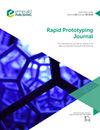左心耳封堵规划的3D打印模型:详细的工作流程
IF 3.6
4区 工程技术
Q1 ENGINEERING, MECHANICAL
引用次数: 2
摘要
目的左心耳闭塞(LAAO)是一种结构性介入心脏病学手术,为增材制造技术的应用提供了多种可能性。文献显示,使用3d打印模型进行LAAO手术计划和闭塞装置选择的兴趣越来越大。本研究旨在描述一个完整的工作流程,以创建用于LAAO程序规划的3d打印LAA模型。设计/方法/方法工作流程从患者的计算机断层扫描诊断图像选择开始。商业软件中的分割以标准镶嵌语言(STL)格式提供初始几何模型,然后在专用软件中进行预处理以便打印。模型使用商用立体光刻机打印,并进行后处理。根据所描述的工作流程生成的模型已在佛罗伦萨Careggi医院用于10例LAAO辅助计划工具,证明了与最先进的设备选择软件的良好相关性,并提高了外科医生对患者解剖结构和设备定位的理解。原创/价值3d打印模型LAAO规划已经在文献中描述。本文的新颖之处在于详细描述了用于创建这些模型的健壮工作流。结果表明,该方法具有较好的鲁棒性。本文章由计算机程序翻译,如有差异,请以英文原文为准。
3D-Printed models for left atrial appendage occlusion planning: a detailed workflow
Purpose
Left atrial appendage occlusion (LAAO) is a structural interventional cardiology procedure that offers several possibilities for the application of additive manufacturing technologies. The literature shows a growing interest in the use of 3D-printed models for LAAO procedure planning and occlusion device choice. This study aims to describe a full workflow to create a 3D-printed LAA model for LAAO procedure planning.
Design/methodology/approach
The workflow starts with the patient’s computed tomography diagnostic image selection. Segmentation in a commercial software provides initial geometrical models in standard tessellation language (STL) format that are then preprocessed for print in dedicated software. Models are printed using a commercial stereolithography machine and postprocessing is performed.
Findings
Models produced with the described workflow have been used at the Careggi Hospital of Florence as LAAO auxiliary planning tool in 10 cases of interest, demonstrating a good correlation with state-of-the-art software for device selection and improving the surgeon’s understanding of patient anatomy and device positioning.
Originality/value
3D-printed models for the LAAO planning are already described in the literature. The novelty of the article lies in the detailed description of a robust workflow for the creation of these models. The robustness of the method is demonstrated by the coherent results obtained for the 10 different cases studied.
求助全文
通过发布文献求助,成功后即可免费获取论文全文。
去求助
来源期刊

Rapid Prototyping Journal
工程技术-材料科学:综合
CiteScore
8.30
自引率
10.30%
发文量
137
审稿时长
4.6 months
期刊介绍:
Rapid Prototyping Journal concentrates on development in a manufacturing environment but covers applications in other areas, such as medicine and construction. All papers published in this field are scattered over a wide range of international publications, none of which actually specializes in this particular discipline, this journal is a vital resource for anyone involved in additive manufacturing. It draws together important refereed papers on all aspects of AM from distinguished sources all over the world, to give a truly international perspective on this dynamic and exciting area.
-Benchmarking – certification and qualification in AM-
Mass customisation in AM-
Design for AM-
Materials aspects-
Reviews of processes/applications-
CAD and other software aspects-
Enhancement of existing processes-
Integration with design process-
Management implications-
New AM processes-
Novel applications of AM parts-
AM for tooling-
Medical applications-
Reverse engineering in relation to AM-
Additive & Subtractive hybrid manufacturing-
Industrialisation
 求助内容:
求助内容: 应助结果提醒方式:
应助结果提醒方式:


